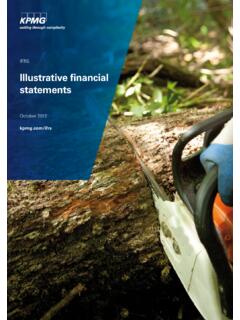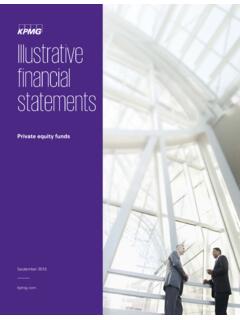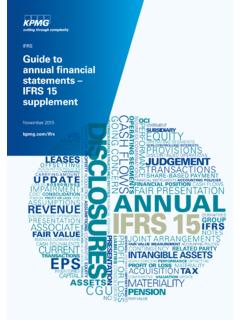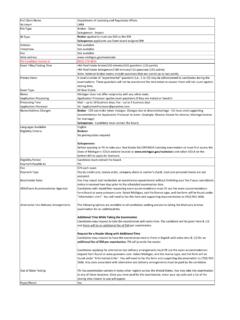Transcription of Real estate leases - KPMG
1 real estate leasesThe tenant perspectiveIFRS 16 October tenant perspective 11 At a glance Key impacts Financial ratios Key considerations 32 Lease definition Overview Applying the definition model to real estate Typical real estate arrangements Recognition exemptions 103 Separating components of a contract Overview Typical components in real estate contracts Property taxes 154 Discount rates Overview Incremental borrowing rates for property Loan-to-value restrictions 205 Lease term Overview Initial assessment of lease term Common considerations Subsequent reassessment of lease term Common considerations 256 Lease payments Overview Fixed and in-substance fixed payments Variable lease payments Value-added tax 347 The right-of-use asset Initial measurement Subsequent measurement Restoration costs 388 Lease modifications Increase in leased space Adding a floor Increase in lease term Reduction in rent Compensation for inconvenience 459 Sale-and-leaseback 4610 Transition considerations Data extraction challenges Key transition decisions for tenants Sale-and-leaseback on transition 53 Appendix I IFRS 16 at a glance 55 Keeping in touch 56 About this publication 58 Acknowledgements 58 2018 KPMG IFRG Limited, a UK company, limited by guarantee.
2 All rights reserved. The tenant perspective real estate leases will be at the heart of many IFRS 16 implementation projects. They are the big-ticket leases that almost every business has, from retailers to banks to media companies. real estate leases pose many practical accounting challenges for tenants the underlying asset has a high value, lease terms can be long, discount rates can be complex to determine, the leases often contain multiple options and rent adjustment mechanisms, and the contracts can contain lease and non-lease components. On top of these challenges, tenants will find that the new standard significantly changes how they account for their real estate leases , impacting many key financial ratios. A successful implementation project will therefore require a good working understanding of the new standard, and of the contracts themselves.
3 This publication covers key areas of the standard that are particularly relevant to tenants in real estate leases . Each section is illustrated with examples based on real -life terms and conditions. A companion publication looking at real estate leases from the landlord s perspective is coming soon. More in-depth guidance on particularly complex areas of the new standard, such as discount rates and transition, is available at In the meantime, we hope this publication will help you apply the new standard to your real estate leases . Kimber Bascom Ramon Jubels Sylvie Leger Brian O Donovan KPMG s global IFRS leases leadership team KPMG International Standards Group2 | real estate leases The tenant perspective 2018 KPMG IFRG Limited, a UK company, limited by guarantee. All rights At a glance The new standard significantly changes how a tenant accounts for its real estate leases , impacting many key ratios.
4 Key impacts Financial ratios Under the new standard, a tenant brings its real estate leases on-balance sheet, including those previously classified as operating leases under IAS 17 leases . The only exception will be real estate leases that qualify for the short-term recognition exemption. Many financial ratios will be impacted by the adoption of the new standard, with many very sensitive to inputs such as the discount rates used. To illustrate, a tenant with an IAS 17 operating lease with regular, fixed lease payments will experience the following impacts on its key financial ratios when applying the new of bringing an operating lease with fixed rents on-balance sheetGearing/leverage Higher, due to recognition of lease liabilities for the first timeAsset turnoverLower, because right-of-use assets will be recognised for the first time and therefore total assets will be higherCurrent ratioLower, because the current portion of the lease liability will be higherOperating profit/earnings before interest and tax (EBIT)Higher, because depreciation will be lower than the lease expense recognised under IAS 17 Earnings before interest, tax, depreciation and amortisation (EBITDA)Higher, due to the elimination of rent expense.
5 Lease payments will be reflected as depreciation expense and interest expenseInterest cover Lower, because the increase in EBIT will be proportionally much lower than the increase in interest expense 2018 KPMG IFRG Limited, a UK company, limited by guarantee. All rights Key considerations Identifying all lease agreements and extracting lease data. Tenants will now recognise most leases on-balance sheet. This may require a substantial effort to identify all leases with payments that should be included in the lease liability, and whether they need to be subsequently reassessed for changes in lease payments . New estimates and judgements. The new standard introduces new estimates and judgements that affect the measurement of lease liabilities. A tenant determines the liability at the commencement date and may be required to revise it the assessment of whether an option is reasonably certain to be exercised (or not exercised).
6 This will require ongoing monitoring and increase financial statement volatility. Balance sheet volatility. The new standard introduces financial statement volatility to gross assets and liabilities for tenants, because of the requirement to reassess certain key estimates and judgements at each reporting date. This may impact a tenant s ability to accurately predict and forecast results and will require ongoing monitoring. Changes in contract terms and business practices. To minimise the impact of the new standard, some tenants may wish to reconsider certain contract terms and business practices changes in the structuring or pricing of a lease agreement, including the type of variability of lease payments and the inclusion of options in the contract. The new standard is therefore likely to affect departments beyond financial reporting including treasury, tax, legal, procurement, real estate , budgeting, sales, internal audit and IT.
7 New systems and processes. Systems and process changes may be required to capture the data necessary to comply with the new requirements. New calculations and review processes will be needed to measure the lease liability at commencement and to subsequently identify when a lease needs to be reassessed and remeasured to reflect changes in lease payments . Transition considerations. A key early decision is how to make the transition to the new standard. The extent of information required by tenants in 2019 will depend on the transition approach chosen under a modified retrospective approach, if the lessee elects to measure the right-of-use asset at an amount equal to the lease liability, then historical information is not needed because liabilities for operating leases are measured based on remaining lease payments , and finance leases remeasured at the carrying amount of the lease liability under IAS 17.
8 Careful communication with stakeholders. Investors and other stakeholders will want to understand the new standard s impact on the business. Areas of interest may include the effect on financial results, the costs of implementation and any proposed changes to business practices. Sufficient documentation. The judgements, assumptions and estimates applied in determining how to measure the lease liability at the commencement date, as well as on reassessment, will need to be At a glance Key considerations 4 | real estate leases The tenant perspective 2018 KPMG IFRG Limited, a UK company, limited by guarantee. All rights Lease definition Identifying a lease of real estate is usually straightforward but some scenarios will require OverviewIFRS , B9 A lease is a contract, or part of a contract, that conveys the right to use an asset (the underlying asset) for a period of time in exchange for consideration.
9 If a contract contains a lease, then it will generally be on-balance sheet for the lessee. The key factors to consider when applying the lease definition are as follows. YesWho has the right to direct theuse of the asset who takes the'how and for what purpose' decisions?TenantPredeterminedLandlordCon tract is orcontains aleaseFurtheranalysisrequiredContract doesnot contain aleaseNoNoYesControlover theuse of theidentifiedassetDoes the tenant obtain substantiallyall of the economic benefits?-Specified asset-Capacity portion-Substantive supplier substitution rightIs there an identified asset? Applying the definition model to real estate Types of properties common in real estate leases include: land and buildings; office space: a floor of a building; retail space; specified spots in a car park; and residential property. 2018 KPMG IFRG Limited, a UK company, limited by guarantee.
10 All rights reserved. When applying the lease definition to real estate arrangements, it will usually be clear whether the arrangement meets the lease definition criteria. Key factors to consider when applying the lease definition are as usually met in real estate arrangements?IFRS , BC111 Specified asset Yes. Generally, the address or particular component of a property ( numbered floors of a building or units in a shopping mall) is identified in the portionsYes. Generally, a tenant has exclusive use of the leased property, or a defined portion of that property that is physically distinct ( a floor of a building). In practice, this would be specified in the agreement. IFRS B19, BC112 BC115 Substantive substitution rightsNo. Generally, there are not substantive substitution rights because a tenant physically occupies the leased property and may have invested in leasehold improvements that are not easy to dismantle and reassemble B23 Tenant obtains substantially all of the economic benefits?














